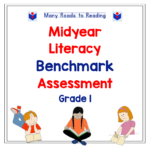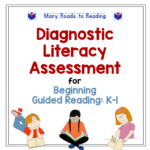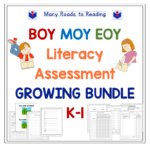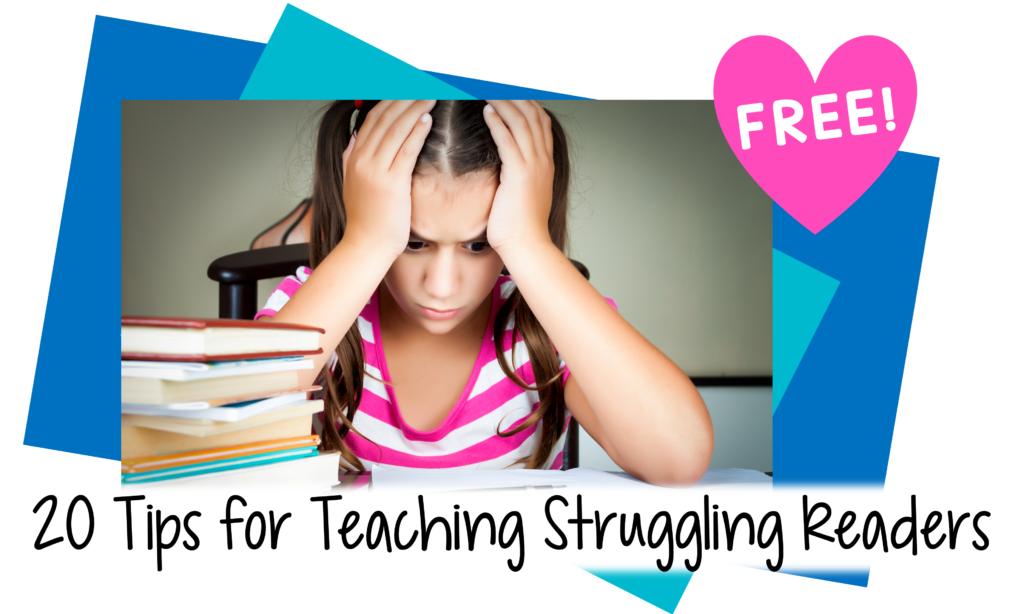
It’s that time of year again!
At the middle of the year, the honeymoon is over for reading teachers. We have to face the fact that, no matter how carefully we have chosen books and planned our lessons, there are going to be some students in our guided reading groups who aren’t progressing as they should. And, contrary to what you might think, these children aren’t always in our lowest reading groups.
But don’t feel bad.
It’s not always possible to identify these needy readers any earlier in the school year. Maybe they do fine as long as their books have consistent language patterns and a minimum of new high frequency words for them to remember. Or perhaps they have managed to sound out words by decoding a couple of consonant sounds and using the context to guess the rest. 
But these inefficient reading strategies only work for so long. Soon the demands of learning to read become overwhelming for these children.
So what are we to do?
Instead of being disappointed with this annual situation, I try to look at the mid-year lag as an opportunity—a chance to sort out who needs extra help and figure out how to give it.
ENTER: midyear benchmark assessment.
At the school where I used to teach reading, the first grade teachers, Title I teachers, and reading specialists decided to create a set of benchmark assessments to evaluate who was and was not meeting our reading standards at the middle of the year. First, we chose a leveled guided reading book that would be our midyear benchmark.
Next I created two lists of words to be used as part of the testing:
- high frequency words that the students should have learned by sight;
- rare phonetic words that the children would probably not have seen before, but which contained phonetic elements we expected the students to be able to decode.
Comparing students’ performance on the nonphonetic sight words and phonetic new words helped us to diagnose the source of their reading difficulties.
How did our benchmark testing go?
Of course, we could identify most of the kids who were having trouble, even before administering the benchmarks. But to our surprise, the testing also pointed to children we had no idea were having difficulty.
 I remember one girl (We’ll call her “Sally”) who started out the year in the top reading group. Sally was highly verbal and had a good visual memory, so she was able to keep up (and hide her struggles from her teacher) by memorizing words and even stories. After a couple of months in 1st grade, though, she dropped to one of the middle groups. But it’s not unusual for students to move from group to group, so her teacher didn’t think much of the change.
I remember one girl (We’ll call her “Sally”) who started out the year in the top reading group. Sally was highly verbal and had a good visual memory, so she was able to keep up (and hide her struggles from her teacher) by memorizing words and even stories. After a couple of months in 1st grade, though, she dropped to one of the middle groups. But it’s not unusual for students to move from group to group, so her teacher didn’t think much of the change.
As you have probably already guessed, the midyear benchmark assessment showed us that Sally was struggling in phonics. She didn’t know all her letter-sound correspondences, especially vowel sounds, and had particular difficulty in blending sounds.
The benchmark testing shed light on several other students who weren’t progressing as we hoped in reading, as well. On the basis of that year’s test results, I formed a supplemental phonics group, in addition to my regular guided reading groups. I made sure to keep the lessons fun, so that these students wouldn’t mind being taken from class for an extra session.
 (That particular year, the midyear strugglers happened to have trouble with phonics. I have observed that most, but not all, of the first graders who hit a roadblock in the middle of the year do so because they haven’t caught on to phonics instruction. But children can have other difficulties that block their reading progress, as well: trouble remembering sight words, poor comprehension, and weak fluency, for example. At times I have formed other types of supplementary skill groups.)
(That particular year, the midyear strugglers happened to have trouble with phonics. I have observed that most, but not all, of the first graders who hit a roadblock in the middle of the year do so because they haven’t caught on to phonics instruction. But children can have other difficulties that block their reading progress, as well: trouble remembering sight words, poor comprehension, and weak fluency, for example. At times I have formed other types of supplementary skill groups.)
Sally’s mother told me then, and years later, that the extra time I spent with Sally in first grade made a huge difference in her attitude toward reading and school, as well as in her future academic achievement. Our midyear benchmark testing was a success!
My new Midyear Literacy Benchmark Assessment
I am a strong believer in testing—useful testing, that is. As a reading specialist, I couldn’t teach without it. I never begin working with a student until I have conducted diagnostic testing, and I also like to give running records on a regular basis to determine how well each student is progressing. To me, useful testing is testing that leads directly to students’ progress.
After creating for Teachers Pay Teachers for about a year, I realized that I wasn’t applying one of my teaching strengths as I wrote my educational materials. That strength is diagnosing readers’ strengths and weaknesses, and evaluating their needs. So I have begun to create testing materials—useful testing materials.
The latest is the Midyear Literacy Benchmark Assessment: Grade 1. This midyear benchmark is much like the benchmark my colleagues and I created, but updated to reflect the increased expectations we have for 1st graders in reading. It consists of 5 tests:
- Spelling
- Dictation

- Nonphonetic High Frequency Words
- Phonetic Words
- Running Records (not including the books)
This assessment kit has other benefits:
- I designed it to be highly adaptable, according to a teacher’s curriculum and/or expectations. Teachers can select certain components or use the blank forms to create their own tests.
- The kit includes several class and individual summaries for charting students’ knowledge and progress.
- It can be used diagnostically to determine readers’ strengths and weaknesses.
This midyear assessment is intended as a follow-up to the far more comprehensive Diagnostic Literacy Assessment for Beginning Guided Reading: K-1, for the beginning of the year. This set includes 10 subtests, several class and  individual summary charts, and many resources for setting up guided reading groups at the beginning of the year.
individual summary charts, and many resources for setting up guided reading groups at the beginning of the year.
Both assessment kits are available at a discount, in a GROWING BUNDLE of BOY (beginning of the year), MOY (middle of the year), and EOY (end of the year) literacy assessments for kindergarten and 1st grade.
You can find all my assessment kits at my Teacher’s Pay Teacher’s Store. And there will be more to come! I’m so glad to have found a way to pass on my strengths as a reading specialist to other teachers!
I hope you can find some useful assessment tools to inform your instruction, if you haven’t already.
Happy teaching!


Leave a Reply